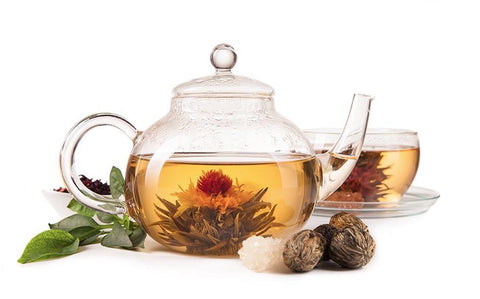 Blooming teas, also called artisan or flowering teas, actually “bloom” as they steep in hot water. The tightly wound bundle of tea leaves gently unfurl or “bloom” into a beautiful visual display revealing the flower. Blooming teas are enjoyed best when brewed in a glass teapot to show off the amazing display that transforms from a ball into a bloom. A large wine glass works well too. After two solid steepings, continue to savor the visual display for several days by simply replenishing with cold water every day.
Blooming teas, also called artisan or flowering teas, actually “bloom” as they steep in hot water. The tightly wound bundle of tea leaves gently unfurl or “bloom” into a beautiful visual display revealing the flower. Blooming teas are enjoyed best when brewed in a glass teapot to show off the amazing display that transforms from a ball into a bloom. A large wine glass works well too. After two solid steepings, continue to savor the visual display for several days by simply replenishing with cold water every day. Production
Hand-sewn blooming teas are created in remote tea gardens in southwestern Yunnan province of China. After the tea leaves are harvested and flattened, they are carefully hand tied with cotton or silk thread around the flowers to create the desired shape. Edible flowers such as chrysanthemum, lily, carnation, hibiscus, marigold, rose, globe amaranth, jasmine and others are used. Flavors or scents are often infused in the flower before the drying process—which varies depending on the type of tea used. White tea blooms are dried in the sun, while green tea blooms are steamed first then dried. If the display tea is made from black tea, the leaves are oxidized first and then dried. Making these special display teas can take all day to complete.
History
The art of creating blooming teas has been around for centuries. Early literature from the Chinese Song Dynasty (960-1279) shows pictures depicting flowering teas, describing them as “designed for the Emperor’s amusement.” These artisan teas were not consumed, probably because of the bitter taste. Eventually blooming teas were made from higher-grade tea leaves, creating a much more appealing flavor. Most flowering teas enjoyed today are made to produce an exotic tea experience that stimulates all the senses.
History
The art of creating blooming teas has been around for centuries. Early literature from the Chinese Song Dynasty (960-1279) shows pictures depicting flowering teas, describing them as “designed for the Emperor’s amusement.” These artisan teas were not consumed, probably because of the bitter taste. Eventually blooming teas were made from higher-grade tea leaves, creating a much more appealing flavor. Most flowering teas enjoyed today are made to produce an exotic tea experience that stimulates all the senses.
Blooming tea is sold in a package of two.














